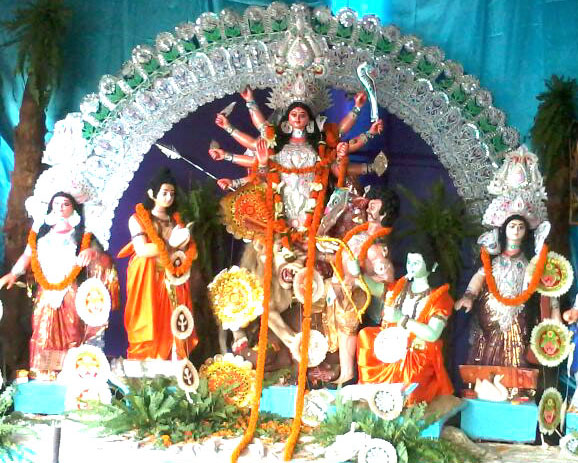
According to Hindu belief, Sharad (Autumn) belongs to Dakshinayana, the night of Devloka. So if any one want to worship the deity at this time, you have to first invoke that deity (awakening). Although goddess Durga was traditionally worshipped as Basanti Durga Puja in spring time, due to contingencies of Rama-Ravan battle, Lord Rama had to invoke Goddess Durga in Sharad Ritu (Autumn), hence the “Akal Bodhan” was performed by him. The term “Akal” means “untimely” and the term “Bodhon” means “awakening” or “invocation”. So Akal Bodhon implies The Untimely Worship.
Several Puranas and other Hindu scriptures mention that before killing Ravana, Rama deliberately performed Durga Puja under the Bilva tree, seeking the blessings of Goddess Parvati. The Bodhana of Goddess Parvati by Rama is known as ‘Akal Bodhana’ as autumn is not the ‘pure time’ for Deva worship. It should be noted that, according to the scriptures, spring is the most popular time for Durga Puja, but in modern times Sharadiya Durga Puja is more common. If Ravana pleases Goddess Parvati by worshiping Chaitra month during spring, the Goddess promises to protect him from all dangers but if he makes any mistake in the Goddess Puja mantra, Sri Sri Chandi. But Devi will abandon him. Because of this, all of Rama’s weapons fail on Ravana. Then Brahma asked Ramachandra to worship Goddess Parvati. Because at this time the goddess comes to the house of her mother and father. On the cusp of Ashtami and Navami when Ram was in deep meditation Ma Durga takes an invisible form and takes away the last lotus. When Ramachandra finally decided to offer one of his eyes (resembled blue lotuses ‘neel kamal’) to Devi Durga. Goddess Durga, being pleased with the devotion of Rama, appeared before him and blessed him with the powers to kill Ravana. In the present age the Akal Bodhan form of the Goddess is worshipped during Sharadiya Navratra.

